
Summer has arrived in New Zealand. The sun is shining, the pohutakawa trees are beginning to bloom bright crimson so it must be Christmas time again. I think I’ve said this before, my northern hemisphere imprinted brain will never get used to Christmas in summertime! 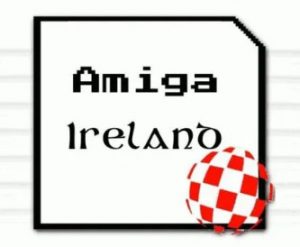 Fortunately, I will be heading to Europe next month to attend Amiga Ireland 2020 so I’m sure to get some traditional European winter weather coupled with a generous helping of great Irish hospitality. So if you are looking for something to do during the cold, dark winter days of January get yourself to Athlone in Ireland and have yourself some triple-A fun. I will be joined by Matthew Leaman, who will be selling a good selection of AmigaKit goodies, and this year, Commodore engineer supreme, Dave Haynie who will be making his first visit to the Ireland show. So what are you waiting for? Come along and enjoy some great company and be one of the first Amigans to help celebrate the Amiga’s 35th birthday.
Fortunately, I will be heading to Europe next month to attend Amiga Ireland 2020 so I’m sure to get some traditional European winter weather coupled with a generous helping of great Irish hospitality. So if you are looking for something to do during the cold, dark winter days of January get yourself to Athlone in Ireland and have yourself some triple-A fun. I will be joined by Matthew Leaman, who will be selling a good selection of AmigaKit goodies, and this year, Commodore engineer supreme, Dave Haynie who will be making his first visit to the Ireland show. So what are you waiting for? Come along and enjoy some great company and be one of the first Amigans to help celebrate the Amiga’s 35th birthday.

Amiga Ireland 2020, 17th – 18th January, Sheraton Hotel, Athlone, Ireland
The long and winding road
Apologies to the Beatles for plagiarising their song title but the development of A-EON’s AmigaOne A1222 has certainly followed a tortuous path. 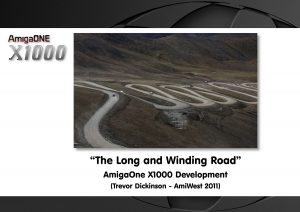 Back in 2011 I gave an AmiWest presentation about the long development but eventually successful release of the AmigaOne X1000 computer. My intro slide showed an image of a winding road with multiple switchbacks which represented my feelings about the twists and turns that affected the X1000 development programme. While the development of the A1222 has not been so difficult from a hardware perspective, a series of unrelated events conspired to slow the development and delay the commercial release. The first A1222 prototypes were manufactured at the end of 2014 and since that time the A1222 Tabor motherboard has certainly been put through its paces. Initially by A-EON’s core Linux team and then Hyperion’s AmigaOS4 beta testers.
Back in 2011 I gave an AmiWest presentation about the long development but eventually successful release of the AmigaOne X1000 computer. My intro slide showed an image of a winding road with multiple switchbacks which represented my feelings about the twists and turns that affected the X1000 development programme. While the development of the A1222 has not been so difficult from a hardware perspective, a series of unrelated events conspired to slow the development and delay the commercial release. The first A1222 prototypes were manufactured at the end of 2014 and since that time the A1222 Tabor motherboard has certainly been put through its paces. Initially by A-EON’s core Linux team and then Hyperion’s AmigaOS4 beta testers.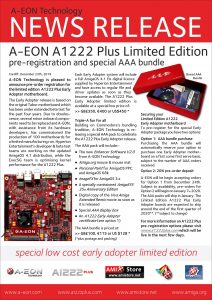 We’ve even had a couple of Tabor motherboards, code-named Atlantis & Pathfinder, running 24/7 helping John Paul Adrian Glaubitz with Debian SPE builds. In the future I will have to write about the A1222 development journey. It should make an interesting story. Anyway, getting back to the A1222, it gave me great pleasure when news of A-EON’s A1222 Plus Early Adopter pre-registration finally broke.
We’ve even had a couple of Tabor motherboards, code-named Atlantis & Pathfinder, running 24/7 helping John Paul Adrian Glaubitz with Debian SPE builds. In the future I will have to write about the A1222 development journey. It should make an interesting story. Anyway, getting back to the A1222, it gave me great pleasure when news of A-EON’s A1222 Plus Early Adopter pre-registration finally broke.
Of course I already announced A-EON’s Early Adopter plans at the recent Amiga 34 and Amiwest 2019 shows.![]() I also revealed in my Soapbox article in the upcoming edition of Amiga Future magazine that Stephen Marshall from Canada was the lucky winner of David Pleasance’s special raffle prize. He will receive an A1222 Plus Early Adopter system donated by A-EON Technology supplied in a Checkmate A1500 case donated by Stephen Jones. The complete system will be assembled tested and supplied by AmigaKit, with Hyperion Entertainment providing the latest version of AmigaOS 4.1. Now that’s what I call cooperation!
I also revealed in my Soapbox article in the upcoming edition of Amiga Future magazine that Stephen Marshall from Canada was the lucky winner of David Pleasance’s special raffle prize. He will receive an A1222 Plus Early Adopter system donated by A-EON Technology supplied in a Checkmate A1500 case donated by Stephen Jones. The complete system will be assembled tested and supplied by AmigaKit, with Hyperion Entertainment providing the latest version of AmigaOS 4.1. Now that’s what I call cooperation! 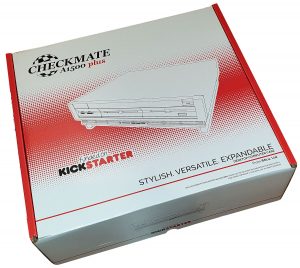 Talking about the Checkmate A1500 case, my own Kickstarter backed case finally arrived in New Zealand a couple of weeks ago. I was planning to install my A1222 Tabor motherboard in the case but unfortunately I discovered I needed a PCI-e extender cable for my Radeon RX gfx card. Without the extender the card cannot be installed. I’m now waiting for the cable to arrive, so for the moment I will have to make do with my existing mini-tower case. So if anyone is planning to order a Checkmate A1500 case for your A1222 remember you will need a PCI-e extender cable.
Talking about the Checkmate A1500 case, my own Kickstarter backed case finally arrived in New Zealand a couple of weeks ago. I was planning to install my A1222 Tabor motherboard in the case but unfortunately I discovered I needed a PCI-e extender cable for my Radeon RX gfx card. Without the extender the card cannot be installed. I’m now waiting for the cable to arrive, so for the moment I will have to make do with my existing mini-tower case. So if anyone is planning to order a Checkmate A1500 case for your A1222 remember you will need a PCI-e extender cable.
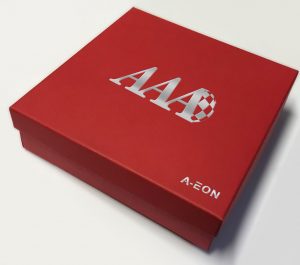
Even better, Tony Wyatt, long-time and active Hyperion Entertainment developer is producing updated AmigaOS 4.1 isos which are being fully tested by the current A1222 AmigaOS4 beta test team. ![]() The newly formed ExecSG team, under the supervision of Steven Solie, is also working hard to optimise and maximise the A1222‘s performance. Meanwhile, Matthew Leaman has been coordinating with the original Varisys design engineers and together they have selected the company who are manufacturing the A1222 Plus Early Adopter run. Since posting the Early Adopter News Release, A-EON has been inundated with requests to purchase the AAA Bundle and for more information about the A1222 Plus. The number of hits on A-EON’s Facebook page has smashed all previous records by almost 100%. As a result we have decided to extend the Option 1 period until the January 31st.
The newly formed ExecSG team, under the supervision of Steven Solie, is also working hard to optimise and maximise the A1222‘s performance. Meanwhile, Matthew Leaman has been coordinating with the original Varisys design engineers and together they have selected the company who are manufacturing the A1222 Plus Early Adopter run. Since posting the Early Adopter News Release, A-EON has been inundated with requests to purchase the AAA Bundle and for more information about the A1222 Plus. The number of hits on A-EON’s Facebook page has smashed all previous records by almost 100%. As a result we have decided to extend the Option 1 period until the January 31st.
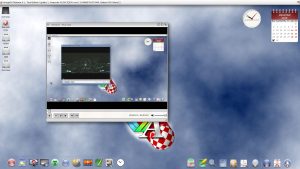
The first hundred customers who purchase and register the new AAA package will have a limted time option to purchase the A1222 Plus motherboard at the special low introductory price. More information will be provided on the a1222plus.com website which will go live in the next few days. By the way, if you are wondering what the Plus is all about, here is a short video entitled, “art imitating life, imitating art“, brought to you by Enhancer Software V2.0 and the AAA Bundle and a nice little surprise from EntwicklerX. Oh yes, and its running on the A1222. 🙂
Croatian Amiga party 2019

It seems only natural that a country which has a red and white chequerboard on its national flag would have an Amiga user group. So it was good to hear from Domagoj Ožanic, who is one of A-EON’s very active A1222 beta testers, about the Croatian Amiga Party that was held in FER (Faculty of Electrical Engineering and Computing) in Zagreb on the 21st of December. Domagoj sent me some photos and a brief report about their Amiga show. The event was by invitation only and was the first Amiga-only party held in Croatia since 2014. Fifteen people turned up for the party although twenty people were expected. According to Domagoj, most of the attendees were diehard 68k Amigans but there was a lot of interest in his A1222 system which he had set up with a selection of classic and next-generation games and demos. He did his best to answers questions from the attendees about availability, costs, status of drivers, boot speed and where to purchase the various games and demos he was presenting on his A1222 beta system.
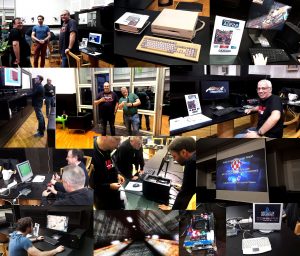
Domagoj wrote, “People were interested in A1222, playing Tower57, Battle Squadron and other Next-Generation games and demos. I saw a sparkle in the eyes from most Amigans that came. It was very important on Amiga party to show legacy software that works….so Battle Squadron was a right thing to do. I showed also Final Writer and UAE JIT with AGA games. First I showed how the A1222 early startup control is the same, then legacy software, then next-generation software. All in 1920×1080 resolution.
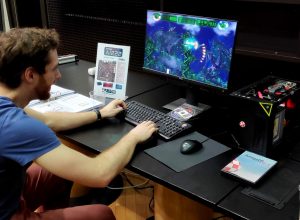
I showed a lot of demos also. Of course – all those demos run this fast and are amazing on our new kernel that was made by our new ExecSG team! That was a first Amiga Party in Croatia since 2014. Now we are ready for the big one in 2020 that will be open for (the general) public.”
Thanks for the update Domagoj and for keeping the Amiga passion alive and kicking in Croatia.
Sage advice
When I attended the recent Amiga34 Germany show in Neuss I came across the Sage II, another early 68000 based computer which was being displayed by Stephan Kraus of classic-computing.org.
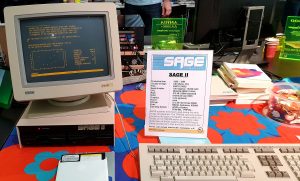
I’m ashamed to say I had no real knowledge of the Sage II machine and Stephan explained to me that the original Hi-Toro development team used 68000 based Sage computers in the early development of the Lorraine prototype, which would eventually become the Amiga computer. Needless to say I was impressed. Later that day I met up with Commodore engineer Dave Haynie, who was a VIP guest at Amiga34 and asked if he had ever used a Sage computer for Amiga development.
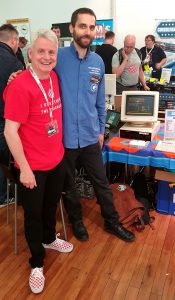
Dave confirmed that he had only used Sun workstations for Amiga development which were provided by Commodore after the Amiga, Inc acquisition. He suggested I contact Dale Luck or RJ Mical who would have more information. Last week I happened to be on a Skype call with Dale Luck to discuss possible plans for an Amiga35 Celebration next year. He confirmed that Hi-Toro/Amiga Inc used several Sage models for the early Lorraine development. Dale also confirmed that, following the Commodore acquisition, the Californian engineers were supplied with nice new Sun workstations. He also revealed he was unsure about the suitability of the Sun workstation for Amiga development and made Commodore buy him a Sage IV machine. However, he said he shouldn’t have worried. The Sun machines worked out very well and the Sage IV was hardly ever used.
The true father of low cost 8-bit computing?
I read the sad news that Charles “Chuck” Ingerham Peddle, an early pioneer of the microcomputer revolution recently passed away. A lot has been written about the contribution that Chuck made to home computing. 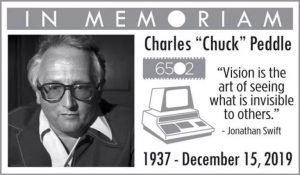 As the lead designer of the low cost 6502 Microprocessor he helped light the fire which dramatically changed the future of home computing and eventually allowed Jack Tramiel and Commodore to deliver computing to the masses. Chuck originally worked for Motorola and could see the benefits of creating a low cost CPU at a time when Motorola was having difficulty selling its 6800 design kit for $300. Unfortunately his bosses at Motorola did not agree with his vision so in August 1974 Chuck jumped ship with Bill Mensch and a small team of other like-minded Motorola engineers and joined MOS Technology in an attempt to realise their technical ambition.
As the lead designer of the low cost 6502 Microprocessor he helped light the fire which dramatically changed the future of home computing and eventually allowed Jack Tramiel and Commodore to deliver computing to the masses. Chuck originally worked for Motorola and could see the benefits of creating a low cost CPU at a time when Motorola was having difficulty selling its 6800 design kit for $300. Unfortunately his bosses at Motorola did not agree with his vision so in August 1974 Chuck jumped ship with Bill Mensch and a small team of other like-minded Motorola engineers and joined MOS Technology in an attempt to realise their technical ambition. 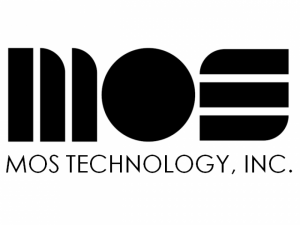 A move that would ultimately allow Commodore to acquire MOS Technology and turbo charge the 8-bit microcomputer revolution. Chuck and his team created the low cost 6501 CPU which was pin compatible with Motorola’s 6800 (although actually incompatible with the 6800) which allowed hobbyists to use existing Motorola development systems. However, on the 6501‘s release in 1975, Motorola sued MOS Technology claiming the design was based on its 6800 CPU. In an attempt to circumvent the legal challenge, Chuck and his team made a few simple design changes to create the 6502 CPU which was pin incompatible with Motorola’s 6800 and sold for $25, a fraction of the costs of other CPUs at that time.
A move that would ultimately allow Commodore to acquire MOS Technology and turbo charge the 8-bit microcomputer revolution. Chuck and his team created the low cost 6501 CPU which was pin compatible with Motorola’s 6800 (although actually incompatible with the 6800) which allowed hobbyists to use existing Motorola development systems. However, on the 6501‘s release in 1975, Motorola sued MOS Technology claiming the design was based on its 6800 CPU. In an attempt to circumvent the legal challenge, Chuck and his team made a few simple design changes to create the 6502 CPU which was pin incompatible with Motorola’s 6800 and sold for $25, a fraction of the costs of other CPUs at that time.
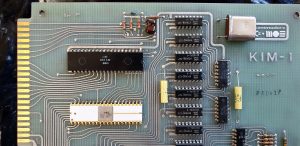
No longer able to use existing Motorola development kits, Chuck created the KIM-1, a small single board computer to showcase the 6502 CPU. Priced at $245 for the Kim-1 kit, it allowed engineers and hobbyists to build their own computer for under $500 with the addition of a PSU, cassette tape player and a user terminal. However, Motorola was a massive company with deep pockets and faced with an expensive legal challenge MOS Technology eventually settled with Motorola in 1976. Coincidentally, MOS Technology also had a thriving calculator IC business and, just like Commodore, its business collapsed when Texas Instruments entered the market with its own calculator products. In late 1976 Commodore acquired MOS Technology for $12m and Chuck Peddle was appointed Chief Engineer. Peddle convinced Tramiel that the calculator business was a dead end and the new craze would be home computers. Fortunately, Tramiel agreed and the rest as they say is history.
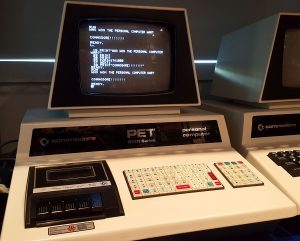
Peddle designed the Commodore PET 2001 which was released in 1977 and the 6502 CPU, and variations of its design, went on to power a whole range of 8-bit machines fueling the microcomputer craze of the late 1970s & early 1980s. In addition to the PET, the 6502 CPU (and its variations) powered the Apple I & II, VIC20, the Atari 2600 and Atari 8-bit family, Nintendo NES, Oric, Acorn Atom, BBC Micro, Atari Lynx and the record selling Commodore C64 plus many others. The 6502 design was also licensed to other companies such as Rockwell and Synertek and in its CMOS form, developed by Bill Mensch who is a co-owner of the 6502 patent, continues to be used in hundreds of million embedded systems. Peddle left Commodore in 1980. My first computer was a Commodore CBM 4032 and Chuck’s passing is especially poignant for me. RIP Chuck. You were a true pioneer of the microcomputer revolution.
Christmas Presents
If you are already the lucky owner of A-EON’s Enhancer Sofware package for AmigaOS4.x you will already know that it includes advanced graphics drivers for a large selection of RadeonHD gfx cards together with Warp3D-Nova & Warp3D-SI 3D libraries along with many applications, utilities and commodities.![]()
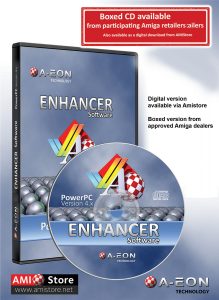 This includes updated versions of TuneNet, AmiDVD, AmiPDF along with powerful interactive utilities like Muliviewer, MulitEdit and ClipViewer plus others like InfoWB, TimeGuard, and the ever popular Workbench CANDI. The Enhancer Software package also inlcudes additional datatypes, audio modes, gadgets and drivers along with the Amisphere Server and special Updater utility which ensures that, as long as you have registered your copy of the Enhancer Software, you can download all the latest freely available updates and bug fixes. Version 1.5 was the last major release although there has also been several smaller releases of key files.
This includes updated versions of TuneNet, AmiDVD, AmiPDF along with powerful interactive utilities like Muliviewer, MulitEdit and ClipViewer plus others like InfoWB, TimeGuard, and the ever popular Workbench CANDI. The Enhancer Software package also inlcudes additional datatypes, audio modes, gadgets and drivers along with the Amisphere Server and special Updater utility which ensures that, as long as you have registered your copy of the Enhancer Software, you can download all the latest freely available updates and bug fixes. Version 1.5 was the last major release although there has also been several smaller releases of key files.
The most recent free update includes new verions of the RadeonHD driver v3.7, Warp3D-Nova library v1.68 and ogles2 library v2.11, a must if you want to play some of the latest games ported to AmigaOS4 by Roman ‘Kas1e’ Kargin based on the excellent GL4ES work of Sebastien ‘ptitSeb’ Chevalier.
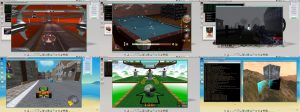
Of course none of this would be possible without the hard work that Hans der Ruiter and Daniel Mussener perfom for A-EON on Warp3D-Nova and openGLES2 respectively. In other good news, Enhancer Software 2.0 is nearing release and includes support for the latest Radeon RX graphics cards and many new exciting features and a few surprises. OK Matthew (Leaman), my lips are sealed for the moment! 😉
Christmas Present two
You realise your family really knows you when your daughter & son-in-law buy you Debbie Harry’s semi-autobiographic memoir, “Face It“, for Christmas. Harry is best known internationally as the talented voice and face of “Blondie“, one of the most successful early American new-wave punk bands of the late 1970’s who went on to sell over 40 millions records worldwide and is still active today. But for Amigans, she will forever be remembered as the extremely beautiful and exotic face linked with the Amiga launch at New York’s Lincoln Center in 1985. A publicity event, which according to Wired webzine, eclipsed even the launch of the Macintosh a year earlier. Wired wrote, “Forget the Apple Macintosh, Ridley Scott, and “1984.” As computer launches go, we’ll take the Commodore Amiga, Andy Warhol, and Debbie Harry. In January 1984—as the entire Western World is well aware—Apple unveiled the Macintosh with its Orwellian “1984” ad during the Superbowl, directed by Ridley Scott. But it was soon eclipsed by Commodore International, the company behind that seminal personal computer, the Commodore 64.” And you tell the kids today…………… 😉 Fortunately for me, my daughter, who was brought up on Amiga computers, understands my Amiga obsession passion. 😉
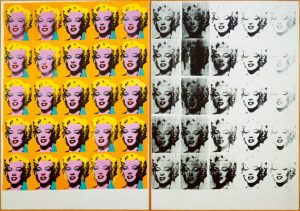
Way back in 1985, Warhol was the acknowledged eclectic king of American pop art, famous for his earlier paintings of Campbell soup cans and Marilyn Monroe montage prints. As every Amigan knows, for the launch of the Amiga, Commodore commissioned Warhol to use the Amiga to create a digital painting of Debbie Harry to demonstrate the Amiga’s advanced graphics capabilities compared to the monochrome Macintosh and limited PC graphics. Working with an early buggy version of ProPaint he created the now iconic digital painting of Harry in the style of his earlier Marilyn Monroe portraits.

What many people don’t know, myself included until I did some background research, was that Warhol and Harry had been friends long before the Amiga launch. In 1980 he had already taken a series of Polaroid photos of Harry and had created several of his trademark mixed medium images of her.

I quickly flicked through the pages of the book to find out if Harry had mentioned the Amiga launch in her book. I was not disappointed. On page 194 there is a picture of Warhol sitting in front of the Amiga, holding an Amiga tank mouse in both hands, with Harry standing behind him leaning on the Amiga monitor with Warhol’s now famous painting of her displayed on the monitor screen.
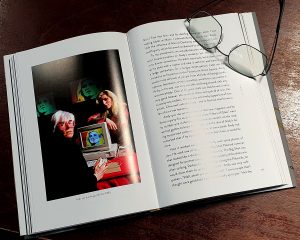
Ah those were the days! Harry also writes about her friendship with Warhol and the Amiga launch but spoils it a little by labelling the famous image in her book, “Andy and the Amiga 2000 in 1985“. Debbie how could you! 😉 If you want to see the original Amiga launch video search Youtube for the link or better still buy or rent a copy of the “Viva Amiga” movie which includes some video of the Lincoln Center event. Warhol later went on to experiment with graphics and video on the Amiga.

Back in 2013, as a homage to Warhol’s original Amiga painting, I created an updated version of Harry’s image for the launch of the AmigaOne X1000. I’ve always thought that imitation is the sincerest form of flattery. 😉
Another Super Nova?
Given my Amiga passion you might be surprised to learn that I do have other business interests. One of the companies I work with has created the Nova platform, an untethered VR motion simulator which they describe as the ultimate in virtual reality simulation. (Note: I did not choose the Nova name which has nothing to do with Warp3D-Nova).
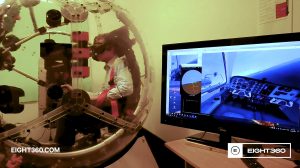
Unlike other VR experiences which can cause mild to severe motion sickness symptoms, well they certainly do with me, Nova’s unique design delivers full 360 degrees of motion from inside a spherical capsule so you can not only see the motion in your VR headset your body can physically experience it too.
Whether you are the fighter ace performing barrel roles over an airfield, or a jet pilot performing high speed, low altitude manoevers through the mountains or even driving a humvee over rough desert terrain the Nova sphere rotates, spins and judders as your body feels the motion that your eyes see in the VR visor.
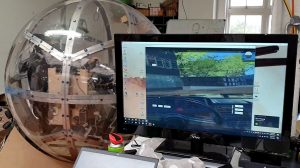
I tested one of the early prototypes a while back and found myself flying upside down with coins and keys falling out of my pockets. My only excuse was it was a very early prototype and the interface and controls mechanism were still in their infancy. 😉 I know, a lame excuse.
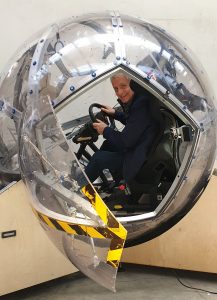
The latest model has ironed out most of the early kinks and Nova already integrates with a host of 3D PC games and simulators including DCS World (Digital Combat Simulator), X-Plane and the NoLimits2 roller coaster simulator. Apart from the hardware design, the real smarts are in the proprietary digital interface which links to the 3D software and controls the servo motors which drive the 360 degree motion of the spherical capsule. Applications include entertainment, flying, advanced driver training and so much more. Remember you saw it here first.
All that is left is to wish all Amigans a very Happy and Prosperous New Year